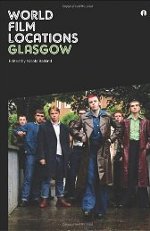This month we review two new books looking at neglected aspects of cinematic history and culture.
 |
The latest volume in the successful series exploring the impact of individual cities on the world of film (and vice versa), World Film Locations: Glasgow focuses on a chamaeleonic city as famous for being other places as itself. It's a city which sells more cinema tickets per capita than almost anywhere else in the world, and the relationship between cinema and its people is explored here alongside its contributions to film production.
Though not intended as a definitive resource on any one aspect of a city's film output, the volumes in this series provide a solid overview, and the Glasgow one is no exception. It's a good starting point for film scholars as well as an interesting guide for tourists, and it will have strong appeal for local people interested in learning more about their city's rich history. An introductory essay on some of its more spectacular cinemas informs the subsequent pieces by providing an understanding of how Glasgow's love of film developed. Woven into it is a brief history of the city itself, which hints at the fortunes that built its extraordinary architecture and also at the poverty that would inform many of its better known cinematic narratives.
What follows is a series of essays interspersed with reviews of key scenes from Glasgow-shot films. Most of these are obvious – the likes of Red Road, One Fine Day and Death Watch – but some stretch boundaries. Monty Python's Meaning Of Life is squeezed in at the edge of what is thematically and geographically reasonable, but provides an interesting anecdote about the Campsie Fells providing the setting for the First Zulu War. Wild Country also takes us out into he nearby hills, whilst we travel to nearby Greenock – arguably part of the same creative community – for Sweet Sixteen.
The city's success as a stand-in for other grand locations is also discussed, from Bollywood's attempts to substitute George Square for Trafalgar Square (the red tarmac is a bit of a giveaway) to Christopher Nolan's insertion of several streets into Gotham City for The Dark Knight and its sequel, and World War Z's decision to turn it into Philadelphia. This aspect of the book seems likely to grow in relevance over time. Equally prescient at the time of writing was the essay here on Glasgow's collaborations with Danish artists, which is not only interesting for its discussions of Dogme but also anticipates Scotland's current obsession with Danish drama and increasing cultural identification with Scandinavia more generally.
As with any compilation work there is some unevenness here, both of quality and tone, but overall it's an impressive book that makes a bold stab at a big subject. It also offers a generous list of suggested titles for further reading. It certainly succeeds in one key objective: to provide a portrait of a city through its cinema. The Glasgow you'll find here is tough but beautiful, economically deprived but culturally rich, possessed of a dark wit and a passion for curry. It's a difficult place to do justice to in one volume but Balkind has acquitted herself well.
 |
Of all the vital figures in early American cinema, Rouben Mamoulian has been the most neglected. This timely volume effectively combines a long-deserved biography with a thorough account of his directorial career on both stage and screen.
Moving quickly through the early years of Mamoulian's life as an Armenian resident of Georgia, author Luhrssen provides just enough detail to explain key influences without weighing down a tale properly focused on his art. There are historically fascinating anecdotes about his mother, a woman challenging traditional values to explore her passion for the theatrical arts, but Mamoulian's own story really began with his arrival in America, a place he loved for its energy and potential. It is to this that Luhrssen devotes 90% of the book, starting with the project that made the director's name – Porgy And Bess, daringly staged on Broadway with an all-black cast. As a production, it played an important role in challenging popular assumptions about race. Here, it introduces the intersection of Mamoulian's career path with the changing social landscape of his adopted country, revealing him as a man who engaged with the dream of a cosmopolitan America at a time when few really understood what that meant.
Some film fans may hesitate to pick up a book that spends much of its time talking about theatre, but the artistic and technical relevance of Mamoulian's stage work to his cinematic endeavours soon becomes apparent. Luhrssen doesn't simply dwell on his reputation as an innovator but successfully establishes it in context. Whether it's social daring – his determination to film Queen Christina his way despite accusations of promoting lesbianism from the unfortunately named Hayes Code enforcers Col. Joy and Walter Wanger – or the promotion of technological change such as his early use of multi-track recording, it is woven into a seamless narrative that effectively illustrates the totality of Mamoulian's vision. His interest in acting, lighting and sound work reveal a rounded man whose struggles to fit into the neatly compartmentalised studio system seem inevitable.
Luhrssen's book is written with passion and benefits from meticulous research. Despite the widely respected erudition of its subject its style is modest and accessible so curious newcomers to the subject should not feel deterred from giving it a try. Its significance as a portrait not just of one man but of a period in history gives it broad appeal. For the enthusiast, it is highly recommended.





















